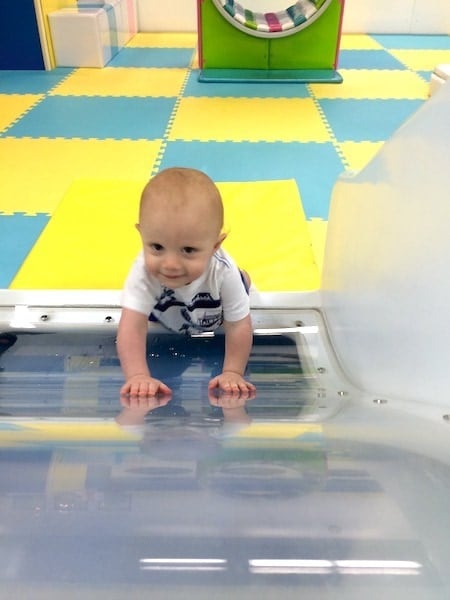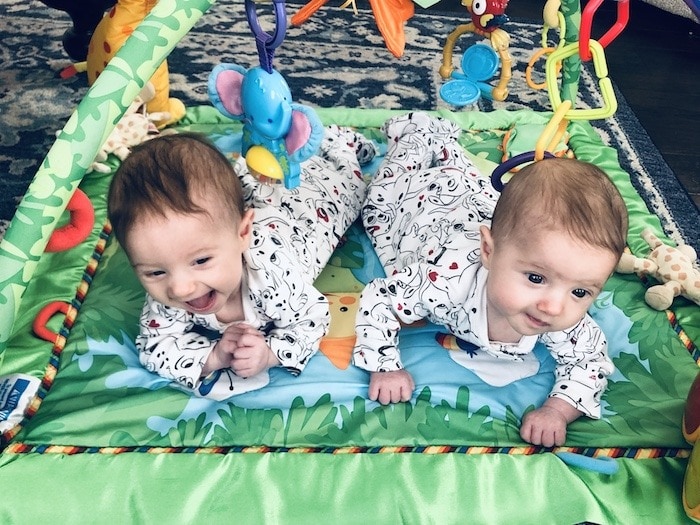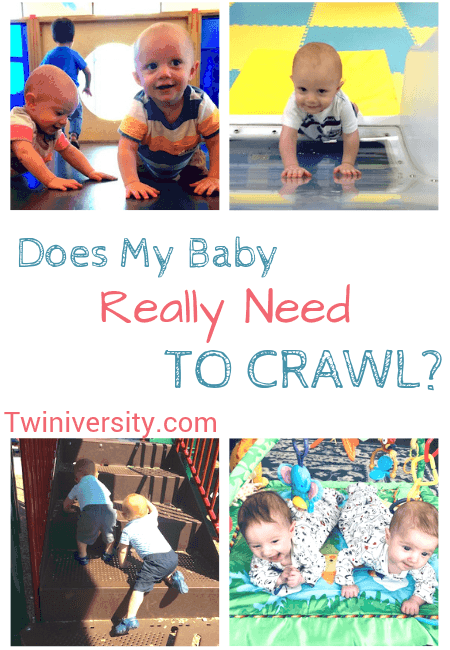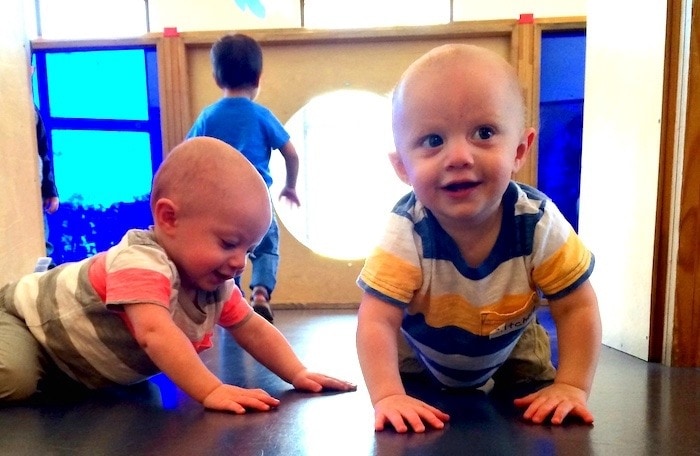Last updated on November 25th, 2023 at 06:18 am
The first year of your twins’ lives is a whirlwind to say the least! It’s filled with so many “firsts”, so many milestones – the first time they look at you and smile, the first time they roll over, the first time they try foods – but is crawling really that important? The ultimate goal as humans is to achieve independent walking, right? So is it really a big deal if babies skip the developmental milestone of crawling? The simple answer is yes, crawling is so important! Yes, the ultimate goal is walking but crawling is a crucial step toward walking. And, yes, skipping crawling is a big deal!
While each child is different, most babies will begin some form of crawling between 7 and 10 months of age. Crawling can come in many forms and patterns, which include:
- Classic hands and knees crawling: babies put weight through their hands and knees and move one arm and the opposite knee forward at the same time.
- Commando crawling (belly crawling): babies pull themselves forward with their arms while dragging their belly against the floor.
- Bear crawling: babies stay on hands and feet moving one arm and the opposite foot.
- Hitch crawling: babies begin on hands and knees but “hitch up” onto 1 foot; this is often not a pattern of concern but if your baby has a history of hip dysplasia or torticollis it should be discussed with your pediatrician.

The benefits of crawling are extensive and cross many domains of development including cognitive development, social-emotional development, gross motor development, fine motor development, and even communication. Here’s how:
- Crawling is one of the first forms of independent mobility, so it encourages self-exploration and stimulates curiosity.
- Crawling strengthens the core muscles, which are so important for posture and balance once babies start standing and walking.
- Crawling develops shoulder stability and upper body strength, which is needed for climbing and even eventually for getting dressed.
- Crawling helps build hip strength and alignment, which again is vital to proper posture and stability when standing and walking.
- Crawling is the first developmental milestone to develop bilateral coordination – moving hands and knees synchronously. Crawling gets both sides of the brain working together!
- Crawling develops fine motor skills. Just like our feet have arches, our hands do, too! Crawling helps open up and flatten those palms while strengthening the tiny muscles (called the intrinsic muscles) of the hands. This is important for grasping, holding, and eventually handwriting.
- Crawling develops vision from a new perspective, which widens the visual field and activates different parts of the brain/visual cortex.

So now that we know how the different ways crawling can look and what the benefits are, the natural next question is, “How can I help my babies learn to crawl?” Here are some simple steps that you can easily incorporate into playtime routines.
Back to Sleep, Tummy to Play
How much tummy time? The more the better! When working on tummy time, the frequency with which your babies are in tummy time is much more important than the duration they stay on their tummy. Parents are often frustrated with tummy time, saying that their babies “hate tummy time”, so they choose to avoid it during play. Please don’t! Start floor play with tummy time; if it lasts a minute, that’s ok…if it lasts 10 minutes, that’s great! Keep coming back to tummy time during play time; you will be surprised how much it adds up to throughout the day when you just increase the frequency.
Lay on the Floor Facing Your Baby
There are few toys more motivating for babies than seeing mommy or daddy’s face. Lying face to face with your babies during tummy time will stimulate eye contact, smiling and socialization. Mirrors are another great motivation for babies – they love to see faces (even their own!).

Position Toys Just Out of Reach
When babies are learning to crawl, they don’t go far initially. Placing toys just out of reach motivates them to start shifting their weight and moving forward to get to that toy. It’s not pretty initially but it will quickly become coordinated.
Help Baby Get on Hands and Knees
Help your babies get on hands and knees and rock forward and backward while singing “Row, Row, Row Your Boat”.
Is your baby “doomed” if they skipped crawling?! No, absolutely not! You can work on crawling skills, even if your babies are already walking independently. Here are some fun and easy ways to do that.
- Imitate crawling – get down on the floor and crawl! It’s likely your babies will see this as a fun game and join in.
- Do baby wheelbarrows – hold your baby’s feet while they “walk” on their hands.
- Use a play tunnel to crawl through.
- Go to the park! There’s so much to see and explore at the playground – find things for your babies to crawl under, through, and around.

If you have concerns regarding crawling or any developmental milestones, discuss them with your pediatrician. All states have Early Intervention programs that can help when needed.

Stacey Haught is a mom to 7 year old Madison, 6 year old twin boys – Mason and Mitchell, and 18 month old twin girls – Sadie and Sophia. She is a pediatric physical therapist but has put her career on hold to stay at home with her rambunctious 5 kids. She resides with her husband and kids just outside of Pittsburgh, PA. Her family enjoys everything outdoors regardless of the season – finding new sledding hills, exploring area parks, and hiking and camping at their family cabin.
References for Crawling
- Early Infant Crawling Experience is Reflected in Later Motor Skill Development. McEwan, MH et al. Perceptual and Motor Skills. 1991.
- Crawling and Walking Infants See the World Differently. Kretch KS, Franchak JM, Adolph KE. Child Development. 2014.
- Development of Early Language and Motor Skills in Preschool Children with Autism. Kim HU. Perceptual and Motor Skills. 2008.
- Pathways.org
- Pediatric Physical Therapy, 5th Edition. Jan S. Tecklin
Related Articles
- Best Toys For Gross Motor Skill Development
- Best Fine Motor Skill Development Toys
- Torticollis: A Physical Therapist’s Perspective








